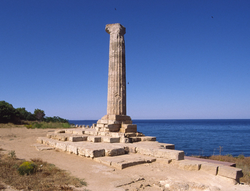Capo Colonna
This article needs additional citations for verification. (December 2016) |
Capo Colonna
Promunturium Lacinium | |
|---|---|
 The last column of the Temple dedicated to Hera Lacinia. | |
| Coordinates: 39°01′46″N 17°12′18″E / 39.02944°N 17.20500°E | |
| Location | Calabria, Italy |
| Offshore water bodies | Ionian Sea |
Capo Colonna (sometimes Capo Colonne or Capo della Colonne; anciently Promunturium Lacinium) is a cape of Calabria located near Crotone.
On the cape still stands a single column of the temple erected to Hera Lacinia, which is said to have been fairly complete in the 16th century, but to have been destroyed to build the episcopal palace at Crotone. It is a Doric column with capital, about 27 ft. in height. Remains of marble roof-tiles have been seen on the spot (Livy xlii.3) and architectural fragments were excavated in 1886-1887 by the Archaeological Institute of America. The sculptures found were mostly buried again, but a few fragments, some decorative terra-cottas and a dedicatory inscription to Hera of the 6th century BC, in private possession at Crotone, are described by F. von Duhn in Notizie degli scavi, 1897, 343 seq. The date of the erection of the temple may be given as 480-440 BC; it is not recorded by any ancient writer.
References
- See R. Koldewey and O. Puchstein, Die griechischen Tempel in Unteritalien und Sicilien (Berlin 1899, 41).
- This article incorporates text from a publication now in the public domain: Chisholm, Hugh, ed. (1911). "Lacinium, Promunturium". Encyclopædia Britannica. Vol. 15 (11th ed.). Cambridge University Press. p. 50.

